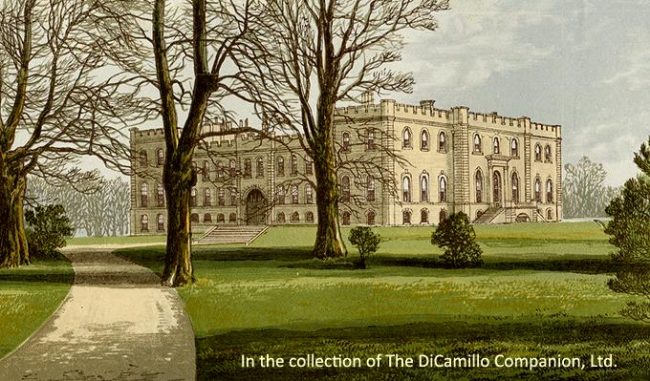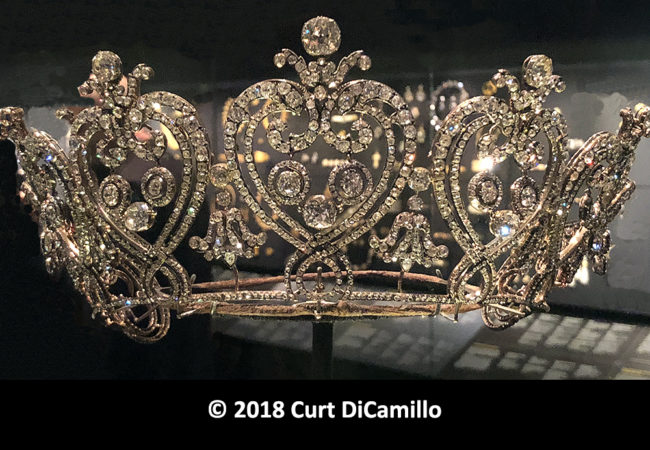
An 1880 color woodblock print of the House from "Morris's County Seats"

The Mancester Tiara, made for Consuelo, Duchess of Mancester, Cartier, 1903. In the collection of the V&A.
Earlier Houses: There were at least three earlier houses on the site: a medieval motte and bailey castle, a fortified medieval manor house, and a Tudor manor house; parts of the latter were probably incorporated into the current house.
House & Family History: The site of Kimbolton Castle was settled at least as far back as the Roman era. In 1066, at the time of the Norman invasion, the manor was held by King Harold himself. After the Norman Conquest a wooden motte and bailey castle was built at Kimbolton under the control of the powerful de Bohun family, who were also responsible for funding the rebuilding of the parish church. King John granted Geoffrey Fitz Peter, Earl of Essex, permission to build a castle on the site of the current House in the early 13th century. No remnants of this castle, most likely a fortified manor house, remains today. Kimbolton passed through the ownership of a number of different families, until it settled with the Wingfield family in the 16th century. The Wingfields rebuilt the medieval castle as a Tudor manor house, parts of which were incorporated into the current House. In 1615 Kimbolton was purchased by Sir Henry Montagu, later 1st Earl of Manchester. Sir Henry and his descendants (later dukes of Manchester) greatly remodeled and enlarged the House, particularly during the late 17th and early 18th centuries under Charles Edward Montagu, 4th Earl of Manchester (created 1st Duke of Manchester). A series of the most prominent architects of the day had a hand in remaking Kimbolton into a luxurious residence: Vanbrugh, Hawksmoor, and Robert Adam all took part in redesigning the House. In 1708 the Venetian painter Giovanni Antonio Pellegrini painted murals on the Staircase, Boudoir, and Chapel. During World War II Kimbolton was used by the British Army Medical Corps. In 1950, with the House in a sad state of repair due to its war-time occupation, the 10th Duke took the decision to sell Kimbolton to what would become Kimbolton School, thus ending 335 years of occupation by the Montagu family. Kimbolton is most famous today for its associations with Queen Catherine of Aragon, first wife of King Henry VIII, who was sent here in April 1534 by Henry for refusing to deny the validity of their marriage. In 1536 the unhappy former wife of the king died in Kimbolton Castle, after years of imprisonment (her body was carried in procession to Peterborough Abbey, today Peterborough Cathedral). The room where Catherine died is called the Queen's Room and was supposedly the inspiration for a scene from Shakespeare's "Henry VIII." Catherine's ghost supposedly walks the floors where she lived, her legs and lower body projecting from the ceiling on one floor, with her head and upper body gliding along the floor above.
Collections: The contents were sold through multiple sales; some items are today in British national museums. The Kimbolton Cabinet, designed by Robert Adam circa 1776 for the Duchess of Manchester, is today in the collection of the Victoria & Albert Museum, London. The cabinet was commissioned by the duchess to display 11 Italian pietra dura (hardstone) plaques and stood in her bedchamber at Kimbolton. It is made of satinwood veneer, with ormolu mounts, and is set with hardstone plaques.
Comments: Pelligrini's Venetian mural paintings are considered his finest work in England.
Garden & Outbuildings: An avenue of giant sequoias was planted in the 19th century. Robert Adam designed the Gatehouse, entrance screen, and St. Neot's Road gates for the 4th Duke of Manchester between 1764 and 1765. Warren House, a former gamekeeper's lodge that faces the Castle, was converted into a decorative folly in the late 18th century. The Grade II*-listed folly is today (2011) ruinous and owned by The Landmark Trust, who are trying to raise £610,000 to restore the building and make it available for holiday lets.
Architect: Robert Adam
Date: 1764-65Architect: John Vanbrugh
Date: Circa 1685Architect: Nicholas Hawksmoor
Date: Circa 1685Architect: Henry Bell
Designed: Courtyard interior
Title: British Galleries, 1500-1900, A Guide Book, The
Author: Winch, Dinah
Year Published: 2001
Publisher: London: Victoria & Albert Museum
ISBN: 1851773622
Book Type: Softback
Title: No Voice From the Hall: Early Memories of a Country House Snooper
Author: Harris, John
Year Published: 1998
Publisher: London: John Murray
ISBN: 0719555671
Book Type: Hardback
Title: Biographical Dictionary of British Architects, 1600-1840, A - SOFTBACK
Author: Colvin, Howard
Year Published: 1995
Publisher: New Haven: Yale University Press
ISBN: 0300072074
Book Type: Softback
House Listed: Grade I
Park Listed: Not Listed
Past Seat / Home of: King Harold, 11th century. De Bohun family, circa 11th-13th centuries. Geoffrey Fitz Peter, Earl of Essex, 13th century. Wingfield family, 16th century. Queen Catherine of Aragon, 16th century. Sir John Popham, 16th century. Alexander George Francis Drogo Montagu, 10th Duke of Manchester, 20th century; Montagu family here from 1615 until 1950.
Current Ownership Type: School
Primary Current Ownership Use: School
Ownership Details: Owned by the Governors of Kimbolton School.
House Open to Public: No
Phone: 01480-860-505
Fax: 01480-860-386
Email: [email protected]
Website: http://www.kimbolton.cambs.sch.uk
Historic Houses Member: No